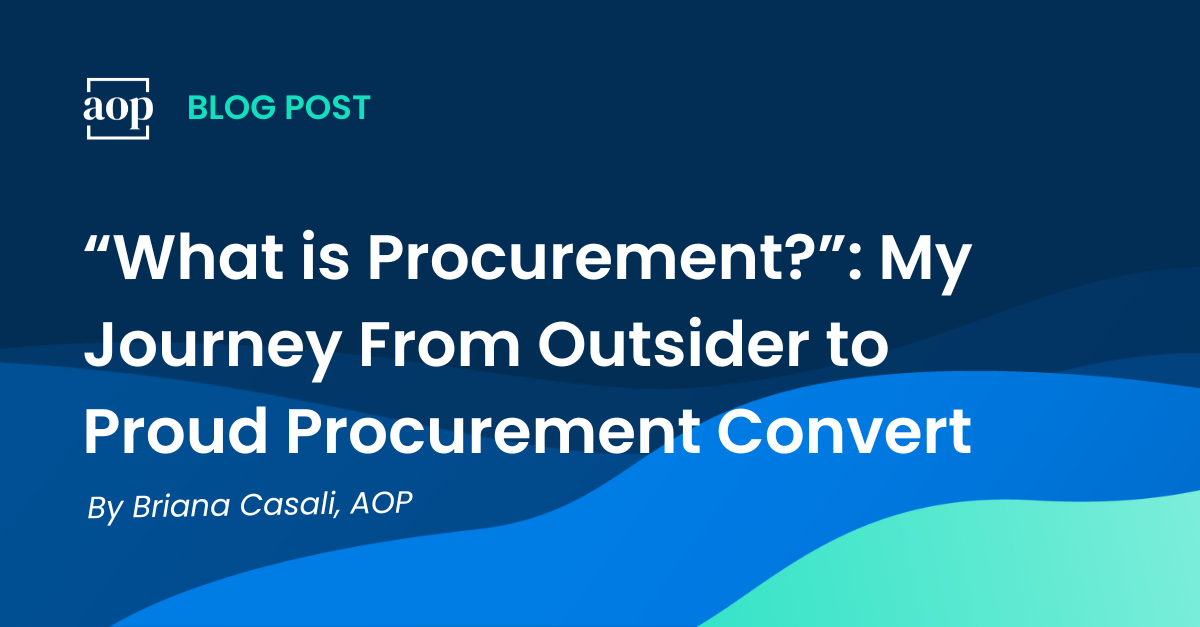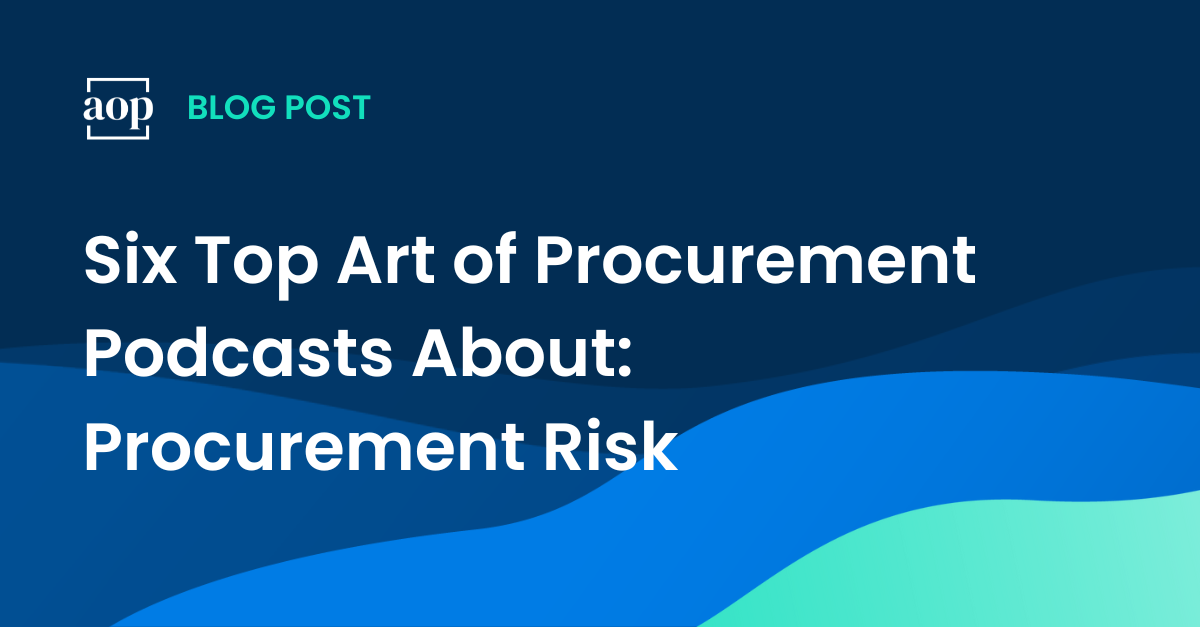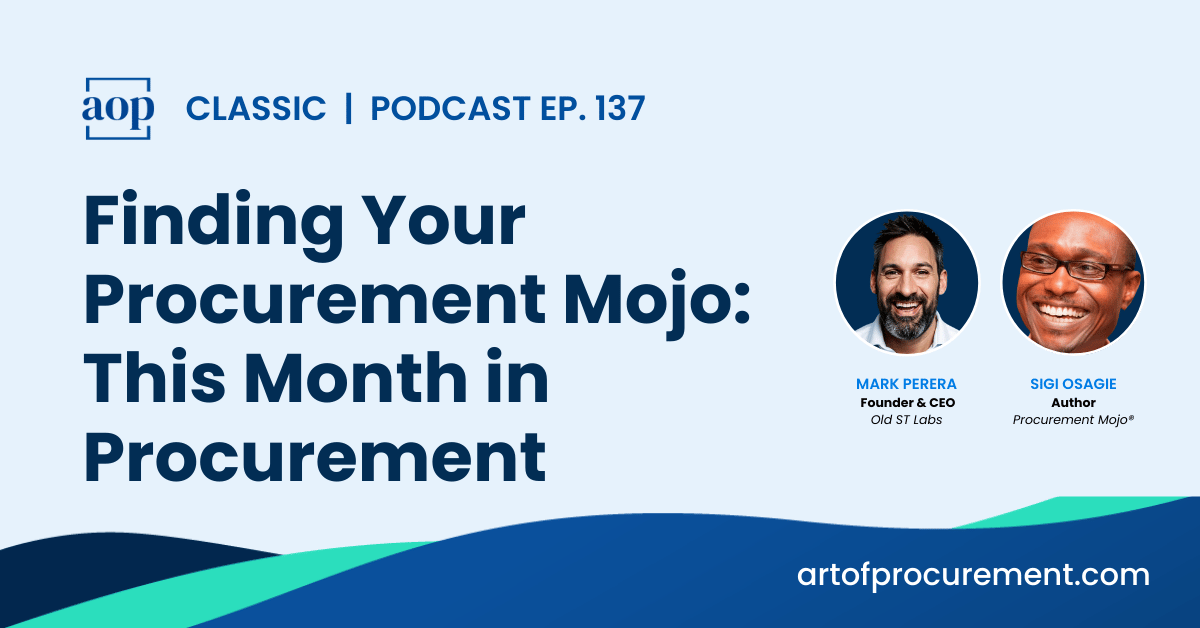7 min read
“What is Procurement?”: My Journey From Outsider to Proud Procurement Convert
Briana Casali : May 13, 2025

At the beginning of every Art of Procurement podcast episode, Philip Ideson asks his guests the exact same question: “Did you find procurement, or did procurement find you?”
In my case, procurement definitely found me, but I’m a little embarrassed to say, I had no idea what it was when it did.
I’ve worked as a professional writer for nearly two decades, and in that time, I’ve moved in and out of different industries: technology, education, hospitality, healthcare, and non-profits. Two years ago, I came across a job listing for a writing position at AOP, and I was immediately drawn into the company culture and team dynamics that came through even in the description (I’ve told anyone who will listen, this is the best team I have ever worked with, and I could tell even from the description that AOP was something special). The role itself was heavy on writing, which I loved, and I was excited to work on my first major podcast and build that part of my writing muscle.
There was just one problem… I had no clue what procurement was.
I actually Googled, “what is procurement?” ahead of my first interview with AOP’s founder Philip Ideson. The best part was, we hit it off so well, that I quickly confessed to my subject matter ignorance, and he assured me that the team – and the material – would help me get up to speed quickly. He was right. It might have taken a few months (or, to be honest, that first year) to feel like I was standing on solid ground, but little by little, procurement came into focus for me.
Benjamin Disraeli once said, “the best way to become acquainted with a subject is to write about it.” For the last two years, I have had the privilege of becoming thoroughly acquainted with procurement. It has been a steep learning curve, but through research, listening and reading, learning from experienced practitioners and industry leaders, leaning on my team, and, ultimately, through writing, I have been on a fascinating journey of discovery about the scope and impact that procurement has.
How had I spent years working for organizations large and small across multiple industries without ever encountering procurement? Looking back, it seems impossible. But, after listening to hundreds of interviews, podcast episodes, webinars, and conversations from procurement leaders over these last two years, I’ve also realized that I’m not alone – there are still many people who, even if they interact with procurement here and there, have very little understanding of who procurement is, what they do, or how to work with them.
Procurement is one of the most powerful, influential functions in an organization, and it is literally hiding in plain sight. And, if I can find my way to understanding and appreciating its impact, then there is no reason why any other department or colleague, no matter where they sit, can’t recognize procurement as the strategic ally they’ve been overlooking all along.
Discovering Procurement
When I first Googled “what is procurement?” the definition seemed simple enough: the process of obtaining goods or services for an organization. But, that’s kind of like saying marketing is just “making ads” or that engineering is just “building stuff” or that payroll is just “writing checks.”
Procurement is one of the most dynamic and impactful areas of business that I’ve covered as a content writer or journalist. They touch nearly every aspect of the business – from products to services to risk and relationships. I’ve learned that procurement isn’t just some back-office function focused only on cutting costs or buying things – it’s about strategically acquiring the right resources that the business needs to not just operate, but to thrive and grow. It’s about building relationships with suppliers that create mutual value throughout the global supply chain, all while managing risk, staying innovative, and giving internal stakeholders the best experience possible.
Learning the Language of Procurement
One of the biggest hurdles I faced as a newcomer to procurement was learning the lingo. Like any discipline or department, procurement seems to have their own “language” and terminology to describe their processes, approach, and goals. One of the more helpful resources I quickly pulled together was my own “procurement dictionary,” where I compiled all of the terms that were new to me. Here’s a sample of what I included:
Procurement: The process of finding, buying, and managing the goods and services an organization needs to function.
Sourcing: Finding and evaluating suppliers who can provide what your organization needs.
Purchasing: The actual transaction of buying goods or services for your business, after sourcing is complete.
Orchestration: Coordinating all the moving parts of the procurement process so they work together smoothly for everyone involved.
Center of Excellence: A team of procurement experts in an organization who develops best practices and provides guidance and support across the business.
Direct/Indirect Spend: Direct spend is money spent on goods and services that go directly into making your company’s products. Indirect spend is money spent on everything else (like office supplies, software, services, etc.) that support the business but don’t go into the actual end product.
Cost Center: A department or function that generates expenses but doesn’t directly contribute to revenue.
Practitioner: Someone who works in procurement.
SRM: Supplier relationship management refers to how procurement builds and maintains good relationships with their suppliers.
P2P/S2P/S2C: Acronyms for common procurement process flows. They are:
- Procure-to-Pay: the process from ordering goods or services from suppliers to payment
- Source-to-Pay: the process of finding suppliers to payment
- Source-to-Contract: the process of finding suppliers to finalizing contracts with them
Tail Spend: The minor, often overlooked purchases that can make up a smaller percent of a company’s spend but involve a large portion of their supplier network
Centralized/Decentralized: These are two different ways of structuring a procurement department within the business.
- Centralized procurement: The procurement team handles all spend across the business
- Decentralized: Individual departments make their own decisions about their budgets and spend
GPO: Procurement can become a member of a Group Purchasing Organization (GPO) that combines the buying power of multiple organizations to negotiate better deals and prices with suppliers
ESG: Environmental, Social, and Governance includes all of the ethical and sustainability issues procurement considers throughout all of its processes.
These might be everyday terms to the average practitioner, but for outsiders to procurement, the lingo can sometimes present barriers to understanding and can muddle communications or expectations among colleagues. So, learning the language procurement uses to describe their roles, activities, and goals made me feel like a little bit more of an insider and helped me to attach meaning to terms and concepts that are otherwise pretty opaque.
What Does Procurement Actually Do?
This was perhaps the biggest area of confusion for me when I first came to procurement. Beyond the basic search engine definitions, I wanted to know more about the actual day-to-day work of practitioners or procurement teams and how that work impacts the business, both tactically and strategically. I realize now that I was grasping to understand procurement’s value or role within the business, which I’ve learned is something even they struggle with effectively communicating. Perhaps, that’s simply because they do so much, including:
- Strategic planning
- Market/spend analysis
- Sourcing
- Negotiation and contract management
- Supplier management and relationship building
- Risk management
- Compliance
- Process improvement and performance measurement
The impact that all of these activities have on the business is long-lasting and profound. Procurement’s ability to deliver in each area directly affects things like product quality, time-to-market, innovation, risk exposure, customer satisfaction, and, of course, profitability.
What also struck me was how procurement interacts with virtually every other function within an organization. For example:
- With Finance: Managing cash flow, payment terms, contracts, and budget planning
- With Operations: Ensuring fulfillment of goods/services
- With Product/Engineering: Finding innovative suppliers to meet new requirements
- With Marketing: Sourcing talent, services, or technology
- With Legal: Risk mitigation and contract management
- With IT: Acquiring technology solutions and ensuring information security
- With HR: Sourcing contingent workers or service providers
Procurement sees it all. Their work, quite literally, touches everything within (and even outside of) the business, giving them enormous leverage for impact, influence, and decision making. It seems like every week I learn something new about how procurement contributes to the business.
The Surprising Side of Procurement: Procurement Can Be a Nail-Biter!
If someone had told me two years ago that I would find procurement exciting – with all due respect to the procurement community – I probably wouldn’t have believed them. Yet, hearing story after story on the podcast or from procurement leaders about the ways their teams have faced challenges and made an impact has turned my outdated misconceptions upside down.
Procurement isn’t some sleepy administrative group of paper shufflers – it’s a high-stakes, dynamic field where the pressure can sometimes be intense and the impact of their decisions can ripple throughout an organization or the supply chain for years to come.
If you’re curious about the more ‘exciting’ side of procurement, here are a few of my favorite episodes from the last few years that show the breadth and depth of procurement’s role:
- Managing Services Procurement on a Grand Scale
- Can Procurement Save the World?
- How Should Procurement Respond to Tariffs?
- Extinction or Opportunity: What is Procurement’s Destiny?
- Leading Through Change with Former Fortune 100 CPO Natasha Gurevich
- A Fresh Take on the Future of Procurement with The Hershey Company’s Sherry Ulsh
- Unleashing the Power of Generative AI in Procurement
- Overcoming Procurement’s Fear of AI
These aren’t just abstract business case studies – they’re real situations with real consequences that affect companies, employees, and customers. And procurement was there, right at the center, driving the action.
A Front-Row Seat to Transformation
The last two years have felt like one long, continuous masterclass in procurement. Every day I am listening to and absorbing insights from the most accomplished, experienced leaders in the field, and after a while, some fascinating patterns start to emerge. It’s probably no surprise, but watching how procurement is changing in real-time because of digital transformation and emerging technologies like AI is like having a front-row seat to how companies, teams, and individuals adapt and evolve to unprecedented change and disruption. The pace at which this change is taking place is staggering, and you can feel the undercurrents of uncertainty (and, if I were being honest, sometimes even a little fear) in many of the conversations we hear.
But, how procurement is meeting this moment (and what an important moment it is. Some might even say a “crossroads” for the profession) is perhaps the most interesting aspect of all. Over the last two years, nearly every procurement leader AOP has spoken with has, on the one hand, acknowledged the AI-powered transformation that’s reshaping everything, but, in the same breath, they emphasize that relationships – real, authentic, one-on-one interactions – matter now in procurement more than ever.
In a world where tech and AI are commoditizing transactional work and taking over large chunks of procurement’s workflow, the human elements of procurement (like trust-building, relationship- and partnership-building, problem-solving, or strategic thinking) have become true differentiators. There are still, and perhaps will always be, some inherently human things that businesses can’t outsource to AI, and, right now, procurement seems to have figured that out better than anyone.
There’s Still So Much To Learn
As with anything new, the more you learn, the more you realize what you don’t know. While I can safely say that I now know what procurement is, I also know I’m still at the very beginning of my journey towards understanding the full scope of this profession.
And, I’m aware that my position as a researcher and writer can only take me so far down that road. I’ll never have the hard-won knowledge and battle scars of a practitioner. I’ll never be in the trenches negotiating complex deals or managing supplier relationships through a crisis. My experience with procurement is purely intellectual and journalistic, which I suppose means that no matter how much I cover, research, or write about procurement, I’ll always be a little bit of an outsider.
But, from that vantage point, I’ve also gained an immense appreciation for this function that oftentimes operates behind the scenes yet still has such a profound impact on an organization. I’ve also come to see procurement professionals as the truly unsung heroes in business who deserve far more recognition than they typically receive.
By listening to their stories – and doing my own part to help tell them – I’ve learned that everyone comes to procurement in their own unique way and time. Like so many others, procurement definitely found me, and I’m very glad that it did.




